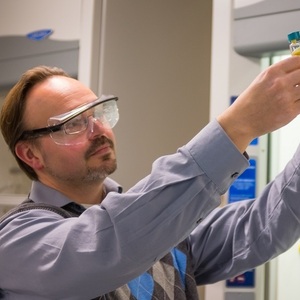Grants help WPI professor hone bio-oil process from mixed waste

Photo: Worcester Polytechnic Institute
January 23, 2020
BY Sharon Gaudin
Chemical engineers at Worcester Polytechnic Institute in Massachusetts are broadening attempts to convert waste into environmentally friendly biofuels, lowering reliance on fossil fuels, cutting the amount of municipal waste going into landfills, and reducing water pollution and unhealthy emissions from petroleum products and landfills.
Michael Timko, associate professor of chemical engineering, has been developing ways to significantly improve the yield of biofuel that can be created from food waste. Now, with a nearly $2 million, three-year grant from the U.S. DOE and $275,000 from the Massachusetts Clean Energy Center, he is expanding his earlier research to mix food waste with municipal green waste, such as yard trimmings, leaves and sticks. By combining the two kinds of waste, he’s aiming to create even more energy-dense oil that can be upgraded to a liquid biofuel. Timko is teaming up on the project with Andrew Teixeira, assistant professor of chemical engineering, and Geoffrey Tompsett, assistant research professor of chemical engineering.
“We have shown that we have methods to convert food waste into energy products,” said Timko, who in 2019 received a prestigious Fulbright U.S. Scholar Award to develop a device he can use in his biofuel research. “Increasing scale is a big goal. If you can handle more waste—different kinds of waste—you can have a larger-scale process. There’s no one silver bullet to creating green energy, but this is a piece of that puzzle. Every time you can add a piece of that puzzle, it matters.”
Timko envisions energy-producing companies one day using his processes to turn food and yard waste from towns, grocery stores, schools, and other organizations into energy.
The U.S. generated more than 262 million tons of municipal solid waste in 2015, about 34 percent of which is made up of food and green waste. Typically, it’s disposed of in landfills. The problem is that landfill space is reaching existing limits and the landfills leach water pollutants, toxins, and greenhouse gases, like methane.
Advertisement
Advertisement
Timko notes that there is significant energy potential in food and green waste, which have a relatively high energy content (approximately 20 megajoules per kilogram; by comparison, kerosene has a heating value of 43.1 megajoules per kilogram).
Collaborators on the DOE grant include researchers at MIT; University of California, Riverside; Massachusetts-based Woods Hole Oceanographic Institution; and Florida-based Mainstream Engineering Corp.
One of the main goals of the project is to develop a catalytic method for converting the municipal solid waste components into an energy-dense oil.
Timko and his research team are investigating the use of hydrothermal liquefaction, a process that uses moderate heat and high pressure to convert wet biomass into crude-like oil. This process can be used with wet waste, so it doesn’t need to be dried first, which would take enough energy to make the process financially untenable.
The hydrothermal liquefaction process converts carbon contained in the feed into products that separate into oil, gas, char and water phases. Researchers are working to improve the hydrothermal process to get the highest-quality fuel possible, to divert the carbon lost to the water into the production of oil, and to minimize the amount of energy put into the process, while maximizing the energy produced. To do that, they are adding various catalysts, such as red mud—an inexpensive, stable and reliable waste product created during the production of aluminum. Another approach is promoting carbon-carbon coupling reactions that save carbon from being lost in the water so it can be used to create more oil, while also decreasing the cost of treating waste water.
Advertisement
Advertisement
“A big challenge in the field is the amount of carbon you lose to the water phase of biofuel production,” said Timko. “If you look at all the challenges to make this competitive with fossil fuels, cost is the biggest one.”
Timko and colleagues also are investigating the best temperature to use and the best mixture of food waste to yard waste to create different oils of different qualities.
Timko said he hopes to have a working pilot by the end of the three-year grant.
Author: Sharon Gaudin
Science Writer, Worcester Polytechnic Institute
skgaudin@wpi.edu
Related Stories
The USDA significantly increased its estimate for 2025-’26 soybean oil use in biofuel production in its latest World Agricultural Supply and Demand Estimates report, released July 11. The outlook for soybean production was revised down.
U.S. fuel ethanol capacity fell slightly in April, while biodiesel and renewable diesel capacity held steady, according to data released by the U.S. EIA on June 30. Feedstock consumption was down when compared to the previous month.
The U.S. EPA on July 8 hosted virtual public hearing to gather input on the agency’s recently released proposed rule to set 2026 and 2027 RFS RVOs. Members of the biofuel industry were among those to offer testimony during the event.
The USDA’s Risk Management Agency is implementing multiple changes to the Camelina pilot insurance program for the 2026 and succeeding crop years. The changes will expand coverage options and provide greater flexibility for producers.
The USDA’s National Agricultural Statistics Service on June 30 released its annual Acreage report, estimating that 83.4 million acres of soybeans have been planted in the U.S. this year, down 4% when compared to 2024.
Upcoming Events










